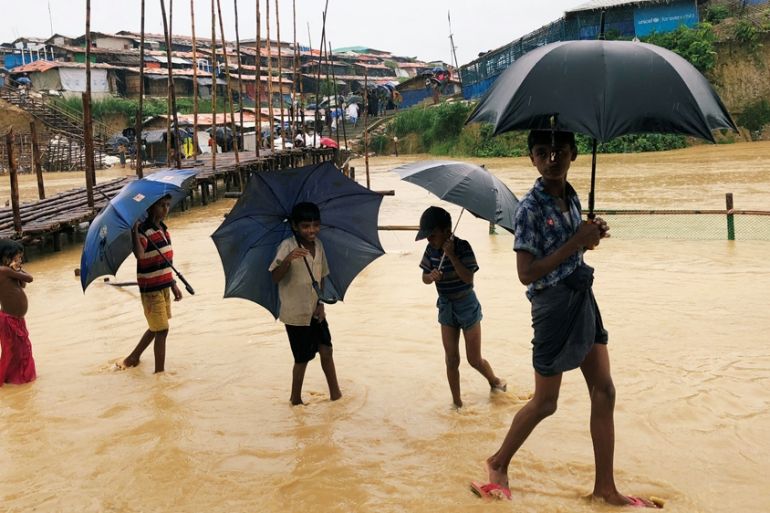Ex-UN chief joins chorus of concern over floods at Rohingya camps
Thousands of families living in Rohingya refugee camps a at risk from flooding and landslides.

Former UN Secretary-General Ban Ki-moon has added his voice to growing concerns that monsoon floods could threaten the lives of Rohingya refugees in sprawling camps in Bangladesh.
Ban said he was “saddened and dismayed” by what he saw while visiting the Kutupalong camp on Wednesday in the southern coastal district of Cox’s Bazar, where more than one million Rohingya are residing after fleeing military-backed crackdown in neighbouring Myanmar.
Keep reading
list of 4 itemsConflict, climate, corruption drive Southeast Asia people trafficking: UN
Bodies of three Rohingya found as Indonesia ends rescue for capsized boat
How is renewed violence in Myanmar affecting the Rohingya?
His comments came days after the United Nations‘s children’s agency (UNICEF) warned that thousands of families living in the refugee camps and Bangladeshi communities in surrounding villages were at risk from flooding and landslides caused by recent heavy rainfall.
The situation was particularly grim in the camps, where many of the more than 4,000 families affected have been relocated to safer areas, UNICEF’s statement said.
One seven-year-old boy drowned following heavy rains, and two children were injured, the agency said. Schools and other facilities serving more than 60,000 children had been damaged, it added.
“Conditions in the camps and host community are deteriorating rapidly because of the brutal weather and the humanitarian needs here are only likely to grow over the coming days with more downpour expected,” said acting UNICEF Bangladesh Representative Alain Balandi Domsam.
At least half a million Rohingya children are in need of humanitarian assistance in Cox’s Bazar overall. According to the World Food Programme, 80 percent of the refugees are entirely dependent on WFP food assistance.
“It’s just impossible to think of how all these young people live in this condition … I know that there are more than half a million young people,” Ban told The Associated Press in an interview during his visit to the camps at Kutupalong.
Vast areas of Bangladesh under water
Low-lying Bangladesh is one of the countries most vulnerable to climate change.
The country has a history of violent cyclones but has reduced the number of casualties from such natural disasters by investing in roads and other public infrastructure, building cyclone shelters and training volunteers across its vast coastal region, which has the world’s largest continuous beach.
Ban visited Bangladesh in his role as head of The Hague-based Global Commission on Adaptation to climate change, or GCA. He was joined by the World Bank’s Chief Executive Officer Kristalina Georgieva and other commissioners of the GCA, which was initiated by the Netherlands and set up in 2018.
Ban and the other officials could see vast areas of the delta nation of 160 million under water as they flew on Air Force helicopters from Dhaka, the capital, to Cox’s Bazar.
‘Bangladesh, of course, is one of the most vulnerable countries and climate change is happening much, much faster,’ said Ban, who also met the Prime Minister Sheikh Hasina to discuss the country’s efforts to adapt to flooding, rising sea levels and extreme weather.
‘Bangladesh has been wisely investing with a vision of Prime Minister Hasina. That is why we are here to learn the lessons from Bangladesh and to disseminate this message to the world far and wide,’ he said.
Georgieva praised Bangladesh’s progress in reducing damage and deaths from the monsoon season floods.
During the ride to Cox’s Bazar, the officials saw low-lying land ‘as far as the eye can see, a lot of water, it is monsoon season, but also roads are elevated so they can sustain the flooding’, she said. ‘More and more green belts protect the inland communities and I also saw that the agriculture is clearly doing well.’
Call for ‘sturdier shelters’
Last year, Human Rights Watch published a report that called on the Bangladeshi government to relocate Rohingya refugees to safer areas.
The report said that refugees ‘should have sturdier shelters and adequate education for their extended stay’.
Kutupalong camp, the largest refugee camp in the world, has more than 626,000 Rohingya refugees who have been displaced in waves over at least three decades.
The largest of these waves was in 2017, when more than 700,000 Rohingya fled across the border from Rakhine State in Myanmar, after the army waged a fierce crackdown against the mostly-Muslim minority.
The report called on Bangladeshi authorities to transfer the Rohingya to smaller, less-congested camps on flatter, proximate land in the same Ukhiya sub-district where Kutupalong is located.
The UN refugee agency has previously estimated 200,000 Rohingya are at risk of floods and landslides.